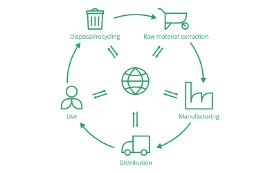
Companies communicating about sustainability has become the standard. That’s a good thing, because it can help customers understand the consequences of their choices, but it can be pretty difficult to make sense of statements on sustainability. Most companies focus on CO2-emissions, but what does that number mean? In this article, we’ll dive a little deeper into the scopes and methods that are used to calculate impact. We’ll also discuss why the only scope that truly represents circular impact is an extensive, cradle to cradle scope – which we at Cirmar call: LCA+ .
Let’s start by drawing a line between scopes and methods. Two concepts that are often used interchangeably, but they represent two fundamentally different aspects of impact calculations.

The first and commonly used method is the Life Cycle Analysis (LCA), which calculates the emissions a product causes from raw materials up to a certain point. It may even include the impact of recycling or disposal processes, but it never includes the consequence of material loss.
Carbon Footprint Analysis zooms in on the greenhouse gas emissions a company produces. It tracks how much CO2 and other gases come from their activities, giving a specific measure of their climate impact.
ESG Reporting is an overall performance report card. It covers three main areas: Environmental (how green you are), Social (how you treat people), and Governance (how well you run things). It’s a way for companies to show stakeholders that they’re not just talking about sustainability – they’re actually doing it.
The scope of an impact calculation defines what stages of a product you include in your assessment. This is incredibly important to understand, because it says a lot about a company’s ambition and degree of transparancy. Even in commonly used impact calculation methods, like LCA, various scopes are applied to similar products. And as you can tell from the scopes below, this can make a big difference.

As you can tell from the images above, a cradle to cradle scope is the most ambitious. Besides that, it is also the one that best represents circularity. We have to elaborate on this point, because this scope can helps us make more sense of the advantages of better, more sustainable products.
Let’s start with a simple rule: sourcing and producing stuff causes emissions. This may not be a shock to you, but it is often underestimated in impact calculations. There are still many companies and people that tend to focus on elements of impact like transport. They might calculate their emissions in terms of the CO2 emitted by the trucks that drive between production facilities and stores. In most cases, the contribution of transport to the total emissions of a company are negligable. It is far more relevant to look into the materials used in products, and what happens to them after a use cycle. That is why we apply our LCA+ scope. This calculates the emissions of products up to the first step in a next use cycle. What is the consequence of using the same amount of materials in a new use cycle?

Making sense of scopes and methods of impact calculations is just a first step. Actually calculating impact is a next step, but it can’t stand alone if we are to transition to a sustainable, circular economy. That is why Cirmar developed C_passport®, the Digital Product Passport that allows companies to record material composition, end of use, and automatically calculate impact. This goes far beyond generating a number that represents the emissions of products, it’s the key to unlocking the full potential of circular products. Do you want to find out how our tech tools can help you improve with insights and provide transparancy to customers? Become a pioneer in a world that is in dire need of sustainable, circular products. Give our free trial a go or get in touch.